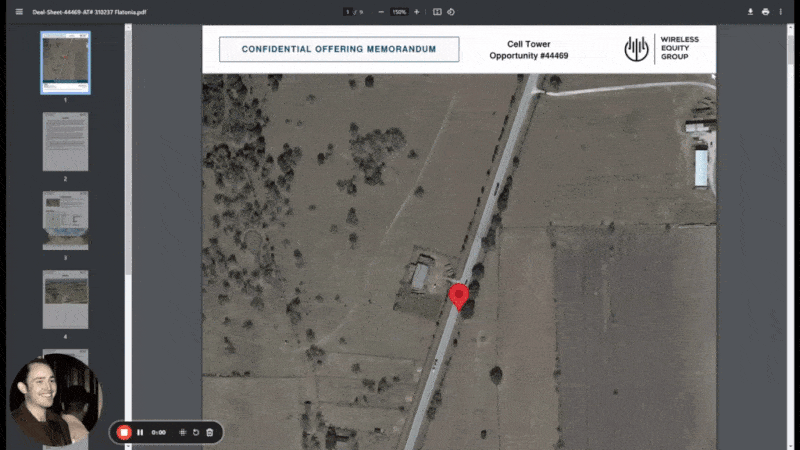At Wireless Equity Group, we specialize in investing in communications infrastructure, including cell towers, rooftop antennas, Distributed Antenna Systems (DAS), and Data Centers. We understand the importance of making informed decisions when it comes to property and asset management. In this article, we’ll explore the nuances between a fixed term and a perpetual easement, helping you determine which is the most beneficial for your specific circumstances.

Contents
Understanding Fixed Term and Perpetual Easements
55-Year Term: A fixed-term agreement, whether it’s a lease or an easement, is a legally binding contract that stipulates a fixed duration of years (typically 55 years). This type of agreement is particularly attractive for its definitiveness and the clarity it provides. It’s a finite arrangement, which means that once the 55 years have elapsed, the terms of the agreement come to an end, and the property owner regains full rights and control over their land.
This temporariness is often preferred by property owners for several reasons:
- Long-term control and planning: Knowing exactly when the agreement ends allows property owners to plan for the future. After 55 years, they might choose to renegotiate the terms, enter into a different agreement, develop the land themselves, or even sell it. This long-term control is particularly appealing to those who have plans or aspirations for the property beyond the span of four decades.
- Anticipating changes in property value or use: Real estate markets and land use trends can change dramatically over time. A 55-year term means that at the end of the period, owners can reassess the situation and make decisions based on the current value and best use of the land. For example, if the area has become more valuable or if there’s a new opportunity for a different type of development, the owner can capitalize on this without being locked into an indefinite agreement.
- Mitigating risk: A fixed-term easement provides a form of risk management. If unforeseen circumstances change the desirability or value of the land, the owner isn’t stuck indefinitely with an agreement that no longer serves their best interests. They have a foreseeable point in time when they can make adjustments and changes.
Perpetual Easement: On the other hand, a perpetual easement is an agreement with no fixed end date. It grants a permanent right of use over a portion of the property to another party, typically until the easement is legally terminated or abandoned. This indefinite nature makes it a very different proposition from a 55-year term.
Some of the characteristics of perpetual easements include:
- Simplicity and long-term stability: For the lessee, a perpetual easement provides long-term stability. They can plan for the future with the assurance that they will have continued use of the land. This can be particularly appealing for entities that require long-term security, like utility companies or telecommunications firms.
- Long-term income for the owner: From the property owner’s perspective, a perpetual easement can offer a stable, long-term income stream. Once the agreement is in place, they can anticipate regular payments for the foreseeable future, which can be an attractive prospect for some.
- Relinquishing control: The major trade-off with a perpetual easement is the loss of control over a portion of the property. The owner agrees to the permanent use of their land by someone else, which can significantly limit their ability to make future changes or decisions regarding that part of the property. This can be a significant drawback, especially if the area’s potential or the owner’s needs change over time.
- Potential for complications: Because perpetual easements last indefinitely, they can sometimes lead to complications down the line, especially if the needs or circumstances of either party change. Terminating or modifying a perpetual easement can involve complex legal processes and negotiations.

Why a 55 Year Term Might Be Better for Certain Property Owners
Choosing a 55-year term can be particularly advantageous for specific scenarios. If you’re not planning to 1031 exchange the funds or if you’re a non-profit organization, a 55-year term might offer more flexibility and financial benefits. Here’s why:
- Future Value Consideration: Property values are not static; they fluctuate based on a variety of factors including market trends, area developments, and changes in the economy. A 55-year term allows you to renegotiate the terms in the future, potentially leading to better financial terms reflective of the property’s value at that time. This is particularly important for properties in areas that are up-and-coming or expected to undergo significant changes. By locking in a perpetual easement, you might miss out on the opportunity to capitalize on these value changes. In contrast, a 55-year term keeps your options open and may lead to a more favorable renegotiation when the term concludes.
- Flexibility: A finite term like 55 years provides a definitive timeline, offering clear sight of when the agreement will end. This allows for strategic long-term planning and the ability to repurpose the property afterward. Whether you plan to develop the property, sell it, or pass it down through generations, having the option to reassess the use of your property at the end of the term is a valuable advantage. Additionally, this flexibility can be crucial if your circumstances change, such as if you wish to relocate or repurpose the land for a different type of development.
- Tax Benefits for Non-Profits: Non-profit organizations often operate under a unique set of financial and tax considerations. Choosing a 55-year term over a perpetual easement can provide specific tax benefits. For instance, the structured payments over a fixed term may align better with a non-profit’s financial planning and budgeting. Furthermore, the potential to renegotiate terms at the end of the 55 years or to reclaim full property rights can significantly benefit a non-profit’s long-term asset management strategy. It’s essential for non-profit organizations to consult with a tax advisor or a financial expert to understand how a 55 year term might impact their tax situation compared to a perpetual easement.
- Mitigating Uncertainty: In an ever-changing world, locking in a perpetual agreement can seem daunting. A 55-year term mitigates this uncertainty by allowing property owners to reassess the situation after the term ends. It provides a safeguard against unforeseen economic, environmental, or market changes that could affect the property’s value or best use. In a sense, it allows property owners to “hedge their bets” against the unpredictable future.
- Adaptability to Technological and Regulatory Changes: In the realm of communications infrastructure, technological advancements are rapid and regulatory landscapes are ever-evolving. A 55-year term provides an opportunity to adapt to these changes. As new technologies emerge or regulations shift, property owners with a fixed-term easement can renegotiate to accommodate these changes, ensuring the property’s use remains optimal and compliant.
Requesting a Valuation: Your First Step
Whether you’re considering a 55-year term or a perpetual easement, the first step is always to request a property valuation. Understanding the worth of your property and the potential income from an easement or lease is crucial in making an informed decision. Wireless Equity Group is here to guide you through this process with our expertise in communications infrastructure investments.
Deciding between a 55-year term and a perpetual easement represents a pivotal juncture in managing your property’s future and optimizing its financial potential. At Wireless Equity Group, we stand at the forefront of empowering property owners with comprehensive knowledge and bespoke services to navigate this significant choice. Our commitment is to partner with you, providing the insights and support needed to make the most informed decision that aligns with your unique circumstances and aspirations.
Tailored Solutions for Individual Needs: We recognize that every property and its owner have distinct needs, visions, and constraints. That’s why we emphasize a personalized approach. By understanding your specific situation, whether it’s the property’s location, your financial objectives, or your long-term goals, we tailor our guidance to ensure that the path you choose is the one best suited to your aspirations.
Comprehensive Analysis for a Clear Path Forward: Our expertise extends beyond surface-level advice. We delve deep into analyzing the implications of each option, considering factors like market trends, regulatory changes, and technological advancements that could impact your property’s value and utility. This thorough analysis ensures that when you make a decision, it’s with a clear understanding of both the immediate benefits and the long-term repercussions.
Empowering You with Knowledge: Knowledge is power, especially when it comes to real estate and investments. We’re dedicated to not just providing recommendations but also educating you about the intricacies of each option. By understanding the nuances of 55-year terms and perpetual easements, you become empowered to make decisions that are not only financially sound but also in harmony with your broader life plans.
A Partnership for Your Property’s Journey: Choosing between a 55-year term and a perpetual easement is not just a transactional decision; it’s a step in the ongoing journey of your property’s story. As your partners, we’re committed to walking this path with you, offering our expertise, support, and services at each turn. Whether it’s today’s decision or tomorrow’s challenges, we’re here to ensure your property’s journey is a prosperous and fulfilling one.
Making the Choice That’s Right for You: The right choice varies for each property owner and hinges on a myriad of factors including future planning, financial objectives, and the unique characteristics of your property. With the right guidance, information, and a partner who understands your vision, you can make a choice that serves your best interests both now and in the long term.
Invitation to Connect and Explore: We invite you to contact us today to discuss your property’s potential and explore the options available to you. Together, we can navigate the complexities of property agreements, ensuring that the decision you make today sets the foundation for a prosperous and secure future. Let Wireless Equity Group be your guide and partner in this important journey. Your property’s future is waiting, and the path you choose now will shape its destiny.





